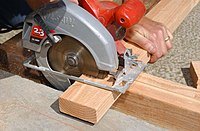
Photo from wikipedia
Though they share the similarity of inducing material failure at a crack tip, the cutting and tearing energies of soft materials cannot be quantitatively related to one another. One of… Click to show full abstract
Though they share the similarity of inducing material failure at a crack tip, the cutting and tearing energies of soft materials cannot be quantitatively related to one another. One of the reasons for this lack of understanding comes from additional complications that arise during standard cutting techniques. Decades ago, Lake and Yeoh (Int J Fract 14(5):509–526 1978) described a natural rubber cutting method that uses a ‘Y-shaped’ sample geometry to mitigate several of these challenges, including minimizing friction and controlling the strain energy available to drive fracture. The latter, understood via a fracture mechanics framework, enables relative tuning between a tearing contribution to the cutting energy and a cutting contribution. In this manuscript, we extend Lake and Yeoh’s largely unreplicated results to softer, more highly deformable polydimethylsiloxane (PDMS) materials. The range of applicability of this technique to variations in material response, sample geometry, boundary conditions, and cutting rate is large. We utilize this flexibility to describe factors leading to the onset of a material-dependent, stick-slip cutting response, which occurs at low cutting rates and high tearing contributions. Furthermore, variation in cutting blade radius reveals a minimum cutting energy threshold even for blades with radii on the order of a few tens of nanometers. For blunter blades, cutting energy reflects the effects of material strain-stiffening. These results establish the Y-shaped cutting geometry as a useful tool in the study of soft fracture.
Journal Title: Experimental Mechanics
Year Published: 2019
Link to full text (if available)
Share on Social Media: Sign Up to like & get
recommendations!